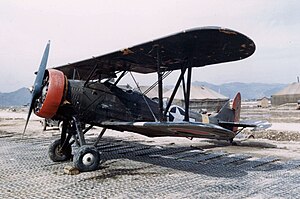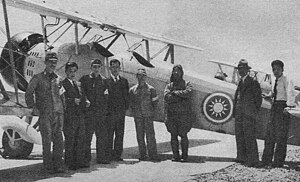| Ki-9 | |
|---|---|
 A former Japanese Tachikawa Ki-9 "Spruce" pictured at airfield K-1 in South Korea in 1951 A former Japanese Tachikawa Ki-9 "Spruce" pictured at airfield K-1 in South Korea in 1951 | |
| General information | |
| Type | Training aircraft |
| Manufacturer | Tachikawa Aircraft Company Ltd |
| Primary user | IJA Air Force |
| Number built | 2,618 |
| History | |
| Manufactured | 1934-1945 |
| Introduction date | 1935 |
| First flight | 7 January 1935 |
| Retired | 1951 |


The Tachikawa Ki-9 (九五式一型練習機, Kyūgo-shiki ichigata renshuki) was an intermediate training aircraft of the Imperial Japanese Army Air Force built by Tachikawa Aircraft Company Ltd in the 1930s. It was known to the Allies under the nickname of "Spruce" during World War II. This aircraft was mistakenly identified as a Tatchikawa by the British.
Design and development
The Ki-9 was a two-seat unequal wingspan biplane design. Tachikawa originally planned to use the same basic airframe for both basic training and intermediate training, differentiating the two models by the use of different engines. The prototype Ki-9 flew on 7 January 1935, powered by a 261 kW (350 hp) nine-cylinder Hitachi Ha-13a radial engine. The second prototype was identical, and the third prototype was powered by a 112 hp (80 kW) Nakajima NZ seven-cylinder radial engine. The third prototype exhibited stability problems due to a center of gravity issue, and as a result, the primary trainer model was abandoned and the Ki-9 was developed only for the intermediate trainer. Tachikawa subsequently developed the Ki-17 for the primary trainer role. The first production aircraft were delivered in 1935.
Operational history
The Ki-9 was introduced to service as the Army Type 95-1 Medium Grade Trainer Model A under the former aircraft naming nomenclature system. The first version had a complex split-axle landing gear with fairings over the top of the wheels. In 1939 this was modified and simplified, the fuselage slightly shortened and the total weight reduced. The resulting Army Type 95-1 Model B or Ki-9-kai had improved maneuverability and flight characteristics. This version was quickly superseded by the Army Type 95-1 Model C, or Ki-9-otsu in full production.
Both versions were used widely for blind-flying training with a folding hood over the rear cockpit, and several were modified with a glazed canopy over the rear cockpit for use as a staff officer transport plane.
Some were pressed into service for use as "special attack" (kamikaze in American terminology) aircraft in the closing days of the war, fitted with either a 100 kg anti-ship bomb or an oil drum filled with explosives or fuel in the rear cockpit.
Production by Tachikawa totaled 2,395 aircraft, ending in 1942. At least another 220 Ki-9s were constructed by Tokyo Gasu Denki (also known as Gasuden) from 1943 to 1945.
The Ki-9 was also flown in wartime by Japanese satellite countries and postwar by the fledgling government of Indonesia, and captured units by the Republic of China.
Variants
- Ki-9 (Army Type 95-1 Medium Grade Trainer Model A): Initial version two-seat intermediate trainer aircraft.
- Ki-9-ko (Army Type 95-1 Medium Grade Trainer Model B): Improved version.
- Ki-9-otsu (Army Type 95-1 Medium Grade Trainer Model C): Standard production version.
Operators
(World War II)
(postwar)
Specifications (Ki-9 Model A)
Data from Japanese Aircraft of the Pacific War
General characteristics
- Crew: 2
- Length: 7.9 m (25 ft 11 in)
- Wingspan: 10.32 m (33 ft 10 in)
- Height: 3.1 m (10 ft 2 in)
- Wing area: 24.5 m (264 sq ft)
- Empty weight: 1,120 kg (2,469 lb)
- Max takeoff weight: 1,580 kg (3,483 lb)
- Powerplant: 1 × Hitachi Ha13a (Army Type 95 350hp Air Cooled Radial) 7-cylinder air-cooled radial piston engine, 195 kW (261 hp) for take-off
- Propellers: 2-bladed wooden fixed-pitch propeller
Performance
- Maximum speed: 240 km/h (150 mph, 130 kn)
- Cruise speed: 150 km/h (93 mph, 81 kn)
- Endurance: 3 hours 30 minutes
- Service ceiling: 5,800 m (19,000 ft)
- Time to altitude: 1,000 m (3,300 ft) in 4 minutes 55 seconds
- Wing loading: 58.2 kg/m (11.9 lb/sq ft)
- Power/mass: 0.18 kW/kg (0.11 hp/lb)
See also
Aircraft of comparable role, configuration, and era
Related lists
References
Notes
- ^ Francillon 1979, p. 248.
- "WWII Japanese weapons in the Korean War". 19 June 2015.
- Lawrence 1945, p. 196.
- Miranda, Justo (2017). Axis Suicide Squads: German and Japanese Secret Projects of the Second World War. England: Fonthill Media Limited. p. 110. ISBN 9781781555651.
Bibliography
- Francillon, René J. (1979). Japanese aircraft of the Pacific War. London: Putnam. ISBN 0-370-30251-6. OCLC 6124909. (new edition 1987 by Putnam Aeronautical Books, ISBN 0-85177-801-1.)
- Green, William & Swanborough, Gordon (n.d.). "Pentagon Over the Islands: The Thirty-Year History of Indonesian Military Aviation". Air Enthusiast Quarterly (2): 154–162. ISSN 0143-5450.
- Lawrence, Joseph (1945). The Observer's Book Of Airplanes. London and New York: Frederick Warne & Co.
External links
| Tachikawa aircraft | |
|---|---|
| Imperial Japanese Army types | |
| World War II Allied reporting names | |
| Imperial Japanese Army Air Service aircraft designations | |
|---|---|
| 1-50 | |
| 51-100 | |
| 100- | |
| Imperial Japanese Army aircraft names | |
|---|---|
| Fighters | |
| Bombers | |
| Transports | |
| Reconnaissance | |
| Trainers | |
| Special Attackers | |
| World War II Allied reporting names for Japanese aircraft | |
|---|---|
| Aircraft in Japanese service |
|
| Foreign aircraft thought to be in Japanese service | |